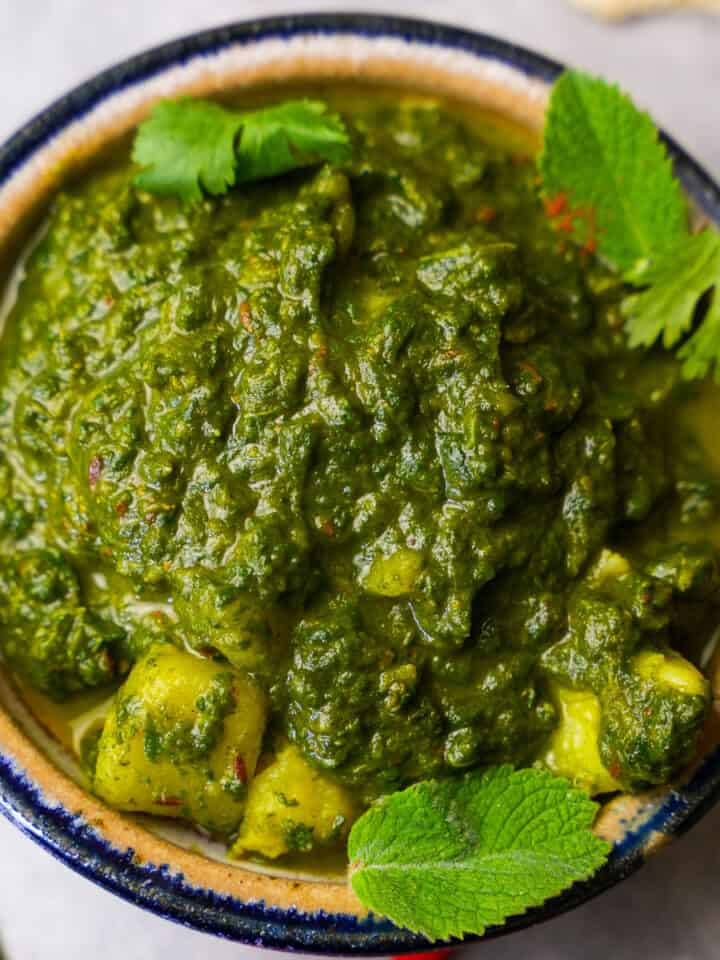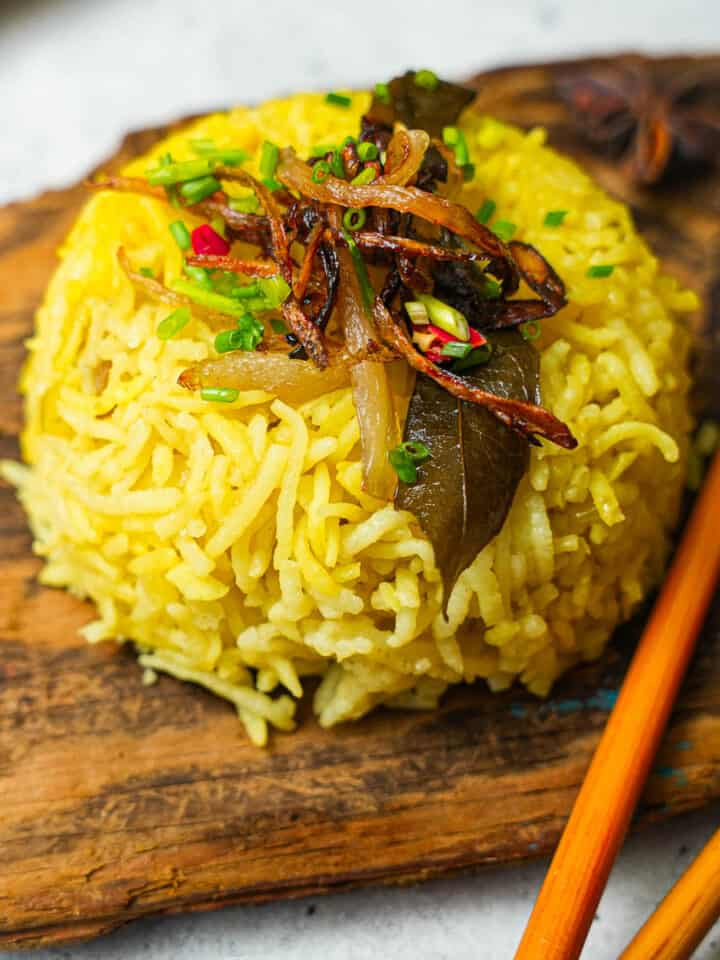*This post may contain affiliate links. Read more »
If you can’t get enough potatoes, you are probably also gonna love Arbi Ki Sabji, a Punjabi taro root curry. This recipe has been tested and loved by more than 400 recipes testers from around the world!


Enter your email & I'll send it to your inbox. Plus, get great new recipes from me every week!
By submitting this form, you consent to receive emails from Cinnamon Snail.
Arbi, also called arvi, is smaller, but you can also use regular taro root like you would for making che khoai mon (Vietnamese Taro Pudding) or bubur cha cha. Anyway, the main things that make this recipe so lovable are its simplicity, speed, and its gosh darn off-the-charts flavor and texture.
Punjab is called the “Land of Five Rivers” due to its geographical location and the five major rivers that flow through the region. These rivers are the Jhelum, Chenab, Ravi, Beas, and Sutlej, collectively forming the fertile and agriculturally rich plains of Punjab. And it is renowned for its rich and hearty vegetarian fare. Arbi Ki Sabji fits perfectly into this tapestry of flavors alongside world-famous dishes like chana masala, Punjabi-style soya chaap, saag aloo, and Punjabi bhindi.
Arbi Ki Sabji is waiting on the other side of this perfect, time-tested recipe to adorn your favorite rice (mine are sattvic biryani and basmati pilau). Let’s dive in and make this killer taro curry together!
Jump to:
🥰Why you'll adore this masala recipe
✊ Vegan AF: This arbi fry recipe is made completely without animal products (like all of my vegan recipes) and is also gluten-free.
🥸 Fool-proof method: With clear photographed step-by-step instructions, you’ll master this dish on your first try.
✅ Tested and Approved Worldwide: Like all of the vegan Indian recipes I share, the North Indian Arbi Sabji has been meticulously perfected and tested by a global team of recipe testers, including within India. This recipe will work seamlessly with various ingredient brands and kitchen equipment. It’s a worldwide hit waiting to happen in your kitchen!


Curry in a Hurry - Vegan Indian Recipe Club! 🍲💌
This 6-day program is 100% FREE. Let me help you to master plant-based Indian cooking!
🌿 Ingredients for taro root curry

Ajwain Seeds
Ajwain are tiny, aromatic seeds are native to India and have a flavor profile that’s a delightful blend of thyme and caraway. They add a distinctive earthy and slightly peppery note to Sukha Kala Chana and it’s also a key ingredient in achar ka masala. If you can’t find ajwain seeds, substitute them with a combination of caraway and cumin seeds.
Arbi
Arbi, is also known by many other names such as Arvi, Eddoe, Colocasia Root, Seppankizhangu, Kachalu, Chembu, and In Karnataka, it’s called Kesuvina Gedde. It’s starchy, with a nutty, earthy flavor and a texture similar to potatoes. Be sure to peel and cook it thoroughly to remove any potential irritation it can cause when raw. If taro root is not available, you can use potatoes as a substitute.

Get my fave cumin seeds for free!
Using this link, add the wild mountain cumin to your cart, spend at least $15 on some of the other absurdly good spices from Burlap & Barrel (they all seriously slap) and the bottle of this bangin' wild mountain cumin becomes FREE, and you will love it so much.

Amchur
Amchur is a tangy seasoning made from powdered dried green mangoes. It’s a common souring agent in Indian cuisine in dishes like shakarkandi ki chaat and masala phool makhana. If you don’t have mango powder on hand, lemon juice or dried sumac can be suitable substitutes.
Hari Mirch
Hari mirch, are small, slender Indian green chilies. They’re sorta an essential element of Indian cooking, contributing a fresh and spicy kick in everything from arhar dal, to peerkgangai kootu. They also make for a killer green chili pickle. Adjust the quantity to suit your spice tolerance. In a pinch, use jalapeños, or serrano peppers as substitutes.
Asafetida
Asafetida, also known as “hing,” is a pungent and aromatic spice that adds depth and umami to the dish. It’s particularly crucial in vegan Indian cuisine to mimic the flavor of garlic and onions in dishes that don’t use them such as sattvic masoor dal and phool makhana sabji. If you can’t find asafetida, you can use garlic powder or finely minced garlic as a substitute.
*See the recipe card at the bottom of the page for exact quantities, nutritional info, and detailed cooking directions.
🤯Variations
Seppankizhangu Roast (Fried Arbi Sabji):
This South Indian arbi recipe, aslo sometimes called Colocasia, is a close cousin to Arbi Ki Sabji. It involves marinating taro root slices with spices and shallow-frying them until they develop a crispy, golden exterior. The bold and spicy flavors make it a delightful snack or side dish.
Patra (Colocasia/Taro Leaf Rolls):
While not exactly the same, Patra is another dish that features taro, this time using the leaves, rolled with a spiced gram flour paste, steamed, sliced, and then shallow-fried. It shares the use of taro but in a different form and preparation method. Another taro leaf recipe I am 100% here for is Filipino laing, which is made with the dried taro leaves. Anyway, you will know the word patra if you are a lover of Bhagavad Gita. Just remember “patraṁ puṣpaṁ phalaṁ toyaṁ” BG 9.26
📖 How to cook arbi sabji
Nail this sabji on your first shot by following these step-by-step instructions with important tips. Or you can follow along with the easy-to-print recipe card towards the bottom of this page.

Step One
Prep Taro Roots:
Begin by peeling the medium-sized arbi roots. Then, cut them into large, elongated quarters.

Step Two
Sear Taro Pieces:
In a pan, heat three tablespoons of oil over medium heat. Sear the taro pieces for about 7-8 minutes until they develop a light golden color. Remove and set them aside.

Step Three
Temper Spices:
Using the same pan, add a tablespoon of oil. Once it’s hot (around 60 seconds), add ajwain seeds and cumin seeds. Let them sizzle briefly to release their flavors.

Step Four
Sauté Aromatics:
Add the grated ginger, minced green chilies, and finely diced yellow onion. Sauté for 5-6 minutes until the onion turns translucent, creating a flavorful base.

Step Five
Spice It Up:
Add diced tomato, ground coriander, amchur (mango powder), asafetida, turmeric powder, Kashmiri red chili powder, and salt. Mix thoroughly and cook until the tomatoes soften, and the mixture thickens.

Step Six
Reincorporate Taro:
Return the fried taro pieces to the pan. Ensure they are well coated with the spicy tomato mixture. Add water and continue cooking for another 5-7 minutes, ensuring the taro is tender inside. If needed, cover the pan with a lid.

Step Seven
Final Touch:
To finish, garnish the dish with fresh cilantro leaves and optional hari mirch (green chilies). Your homemade Arbi Ki Sabji is ready to be enjoyed alongside some vegan tikka masala and mango pickle on a giant pile of steaming hot turmeric rice!
💡Serving Ideas
Don’t let your Arbi Ki Sabji get lonely!
Serve it over fragrant coconut rice with chana dal as the basis for a great big ol’ thali.
Add some other sabjis on the side like parval, olan, aviyal or lauki sabji to your meal.
Add something crispy to the meal, like kanda bhaji, or Medhu vadai. Scoop it all up with parotta or Amritsar kulcha.

👉Tips for nailing this arbi recipe
- Properly Cook Taro: Ensure the taro (Arbi) is fully cooked and tender before serving. Test it with a fork to make sure it’s soft on the inside. Undercooked taro sucks just as bad as an undercooked potato. Maybe worse!
- Handling Taro: Taro roots can cause skin irritation when raw, so handle them with care. Peel them thoroughly and cook until they’re no longer itchy. If using gloves, ensure you still have a safe grasp on your knife or peeler. This isn’t so much an issue with frozen or boiled arbi.
- Cover While Cooking: When simmering the dish, definitely cover the pan with a lid. This helps the taro cook internally and absorb the flavors of the spicy tomato mixture.
🤷♀️Recipe FAQs
Yes, you can use frozen taro as a convenient alternative. However, be sure to thaw and drain it before cooking.
To reduce spiciness, simply decrease the number of green chilies or opt for milder chili powder.
Wearing gloves or applying a small amount of oil on your hands can help prevent skin irritation while peeling taro roots.
Yes, if taro isn’t available, you can substitute it with potatoes. It also works nicely with pumpkin and kabocha squash. The cooking time may vary slightly, so ensure the veggies are tender when serving.
🌡️ Storage: To store Arbi Ki Sabji, transfer it to an airtight container and place it in the refrigerator. Consume it within three days for the best taste and quality.
🥶Avoid freezing, as it can alter the texture of the taro.
🔥 Stovetop Reheating: To reheat on the stovetop, place a pan over medium-low heat. Add a splash of water or vegetable broth to prevent sticking. Stir the Arbi Ki Sabji occasionally as it warms up. Reheat until it reaches your desired temperature.
🌟 Microwave Reheating: When reheating in the microwave, transfer the desired portion to a microwave-safe dish. Cover it with a microwave-safe lid or microwave-safe plate to prevent splatters. Use short, 30-second bursts of heating, checking and stirring between each burst. This helps ensure even heating and prevents overheating.
While I have heard some people claim these are different forms of taro, in my experience eddoe (or eddo) is just a Spanish name for the same veggie.
✌️My faves to serve with taro root:

Arbi Ki Sabji (Indian dry taro curry)
Ingredients
- 8 arbi medium size, (a.k.a. arvi and eddoe)
- 3 tablespoons oil Canola oil, vegetable oil, peanut oil or other
- 1 tablespoon oil Canola oil, vegetable oil, peanut oil or other
- ¼ teaspoon ajwain seeds
- ½ teaspoon cumin seeds
- 1 teaspoon ginger grated
- 2 green chilies (hari mirch), minced
- 1 cup yellow onion small dice
- 1 cup tomato diced
- 2 teaspoons coriander
- 1 teaspoon amchur
- ½ teaspoon asafetida
- ¼ teaspoon turmeric powder
- 1 teaspoon Kashmiri red chili powder
- 1 teaspoon salt
- 1 cup water
- cilantro leaves
- Hari mich thinly sliced (optional)
Instructions
- Peeling the medium-sized arbi, and then quarter them into large, elongated pieces, or cut into discs if you prefer.
- In a pan, heat oil over medium heat. After 90 seconds when the oil is hot, stir-fry the taro for about 7-8 minutes until they turn a light golden color all around. Once done, remove the stir-fried taro pieces and set them aside.
- In the same pan, add a tablespoon of oil. After heating for about 60 seconds, when the oil is hot, add ajwain seeds and cumin seeds and state for about a minute until aromatic.
- Now, add grated ginger, minced green chilies, and finely diced yellow onion. Cook for about 5-6 minutes or until the onion becomes translucent.
- Add diced tomato, ground coriander, amchur (mango powder), asafetida, turmeric powder, Kashmiri red chili powder, and salt to the pan. Mix everything well and cook until the tomatoes soften, and the mixture thickens.
- Return the fried arbi pieces to the pan. Ensure they are well coated with the spicy tomato mixture. Pour in water, and continue to cook covered for another 5-7 minutes, making sure the taro is fully cooked and tender inside.
- Place the cooked arbi in an attractive serving dish and garnish with fresh cilantro leaves and thinly sliced green chilies if desired.
Notes

Enter your email & I'll send it to your inbox. Plus, get great new recipes from me every week!
By submitting this form, you consent to receive emails from Cinnamon Snail.











Heva says
I recently tried this vegan recipe and it was absolutely amazing! The flavors were vibrant and the combination of ingredients was perfect. It's great to see how creative and delicious plant-based dishes can be. This recipe has definitely become one of my favorites. Highly recommend it to everyone, whether you're vegan or not! Keep up the great work in promoting healthy and tasty food options!
Leagle says
a crowd pleaser & easily a finger food for little hands. find taro more forgiving than many potatoes in this kinda twice-fried fashion. also leftovers reheat really well. served dal & bottle gourd & lime pickle bc i can't stop eating lime pickle